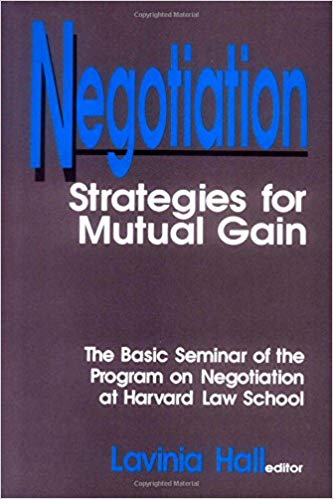This volume is a collection of essays which present key concepts and strategies intended to promote effective negotiation and mutually beneficial dispute resolution. This book is for people in all fields who need to deal with conflict and resolve issues on a continual basis. The book assumes that conflicts, managed well, can provide the impetus for growth, constructive change, and mutual benefits. Ideas for settling disputes, improving communications, and changing the nature of certain debates are covered in this book.
This work is divided into eleven essays in three parts, with an introduction by the editor. This text was published in cooperation with the Harvard Program on Negotiation, and is an outgrowth of a semester-length course in negotiation taught under the auspices of the Program.
PART ONE:
Focuses on outlining frameworks for effective negotiation. Roger Fisher, William Ury and Bruce Patton analyze negotiating power in terms of the parties’ BATNA (Best Alternative To a Negotiated Agreement). Sources of negotiating power include understanding the opposing parties’ interests, forging a good working relationship with other parties to negotiation, suggesting elegant options, invoking external standards of legitimacy, and making commitments. Howard Raiffa explores the uses of third party neutral analysts to produce more efficient negotiated outcomes. Neutral analysts are particularly helpful in integrative bargaining situations. Using case studies he describes specific methods by which neutral analysts can facilitate better settlements. David Straus describes facilitated collaborative problem solving and process management. He stresses the importance of developing a negotiation process in the early stages of negotiation, rather than moving to consider solutions prematurely.
PART TWO:
The authors discuss the application of negotiation frameworks to actual organizations. Frank Sander describes the use of alternative dispute resolution (ADR) in the court system. Lawrence Susskind describes his own consensus-building approach to resolving public disputes. Although negotiation processes currently serve to supplement existing public decision-making procedures, increased use of negotiation has the potential to transform those public procedures, for the better. Robert McKersie and Charles Heckscher each analyze the habits and beliefs which make labor relations so contentious. They suggest changes which will improve the potential for mutual gains decision making in employment relations. Mary Rowe discusses the importance of developing flexible dispute resolution processes, which offer both complainants and complaint handlers’ options regarding how an issue will be resolved. Rowe describes some of the options which characterize an effective dispute resolution system.
PART THREE:
The author discusses the effects of individual’s characteristics on the process of negotiation. Jeffery Rubin describes conflict from a psychological perspective. He describes the psychological tendencies which can lead to conflict escalation or stalemate, and suggests techniques to facilitate de-escalation. Deborah Kolb investigates the effect of gender on negotiation. Gerald Williams assesses the effectiveness of cooperative and aggressive negotiation styles.
Negotiation Strategies for Mutual Gain Attributes
| Author: | Edited by Lavinia Hall |
|---|---|
| Publisher: | Newbury Park, CA: Sage Publications, 1993 |
- Filed in:
- Books, Hall, Lavinia
- Tags:
- ADR, agreement, alternative dispute resolution, bargaining, BATNA, best alternative to a negotiated agreement, bruce patton, collaborative, conflict, conflicts, consensus, cooperation, cooperative, deborah kolb, decision making, dispute, dispute resolution process, dispute resolution processes, dispute resolution system, effective negotiation, frank sander, harvard program on negotiation, HNI, howard raiffa, integrative bargaining, interests, Lawrence Susskind, legitimacy, mutual gain, mutual gains, mutually beneficial, negotiate, negotiated agreement, negotiating, negotiating power, negotiation, negotiation process, negotiation style, negotiation styles, process of negotiation, program on negotiation, relationship, roger fisher, ury, william ury

